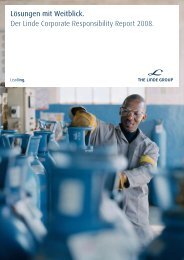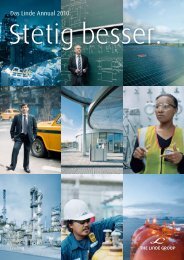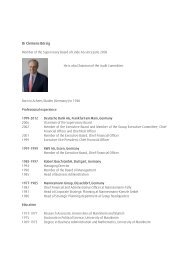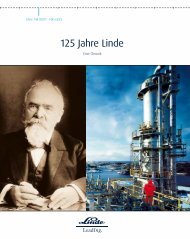The complete history of the development of The - The Linde Group
The complete history of the development of The - The Linde Group
The complete history of the development of The - The Linde Group
You also want an ePaper? Increase the reach of your titles
YUMPU automatically turns print PDFs into web optimized ePapers that Google loves.
58<br />
N o 2064 Special fixation <strong>of</strong> <strong>the</strong><br />
spiral-wound tube coil <strong>of</strong> a heat exchanger.<br />
<strong>The</strong> <strong>development</strong> <strong>of</strong> gas companies outside Europe began in 1968.<br />
Pictured here: transporting liquefied gases in Brazil.<br />
Gas application in <strong>the</strong> construction industry: Flame descaling with<br />
autogenous flame for finishing concrete surfaces.<br />
1968 1969<br />
Warsaw Pact troops end <strong>the</strong> “Prague Spring”<br />
under Alexander Dubcek.<br />
American Neil Armstrong is <strong>the</strong> first man to walk on<br />
<strong>the</strong> moon on July 21.<br />
N o 2082 Process and device<br />
for <strong>the</strong> recovery <strong>of</strong> ammonia syn<strong>the</strong>sis gas.<br />
It would be fully developed, beginning in <strong>the</strong> mid-1960s, under<br />
<strong>the</strong> leadership <strong>of</strong> Hermann <strong>Linde</strong>, Georg Plötz, Joachim Müller,<br />
Hannes Kneissl and Karl Heinz Jungmann. <strong>Linde</strong> received its first<br />
contract to build a petrochemical ethylene plant in Scholven,<br />
near Gelsenkirchen (Veba) in 1965.<br />
Business in technical gases also contributed to <strong>the</strong> economic<br />
strength <strong>of</strong> <strong>the</strong> company. After <strong>the</strong> chemical industry, <strong>the</strong> steel<br />
industry developed into <strong>the</strong> most significant customer sector. <strong>The</strong><br />
production <strong>of</strong> acetylene and inert gases also took on increasing<br />
importance.<br />
Refrigerated buildings benefited almost exclusively from<br />
political <strong>development</strong>s in <strong>the</strong> mid-1950s: first from <strong>the</strong> Korean<br />
war, later from <strong>the</strong> agricultural policies <strong>of</strong> <strong>the</strong> EEC, which led to<br />
considerable agricultural surpluses – to lakes <strong>of</strong> milk and mountains<br />
<strong>of</strong> butter and meat that had to be stored and refrigerated.<br />
In <strong>the</strong> 1950s, <strong>the</strong> engineers in Höllriegelskreuth also worked<br />
on <strong>the</strong> peaceful use <strong>of</strong> nuclear energy, and in 1955 built a facility<br />
for <strong>the</strong> production <strong>of</strong> heavy hydrogen (deuterium). But after<br />
light water reactors became established internationally, <strong>Linde</strong><br />
dropped out <strong>of</strong> this field. One useful thing came out <strong>of</strong> this<br />
venture, however: in <strong>the</strong> production <strong>of</strong> heavy hydrogen, <strong>the</strong><br />
<strong>Linde</strong> engineers made progress for <strong>the</strong> first time in an industrial<br />
process at minus 252 degrees Celsius. Since that time <strong>Linde</strong> is<br />
now among <strong>the</strong> world’s technological leaders in <strong>the</strong> field <strong>of</strong><br />
ultra-low temperatures (cryotechnology).




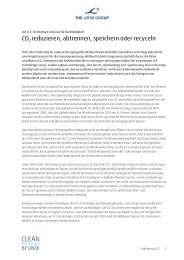

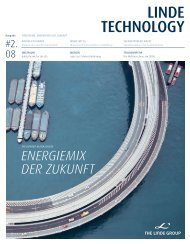

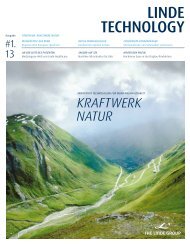

![[41] Anteilsbesitzliste des Linde Konzerns und ... - The Linde Group](https://img.yumpu.com/8356102/1/184x260/41-anteilsbesitzliste-des-linde-konzerns-und-the-linde-group.jpg?quality=85)
![[41] Anteilsbesitzliste des Linde Konzerns und ... - The Linde Group](https://img.yumpu.com/8356076/1/184x260/41-anteilsbesitzliste-des-linde-konzerns-und-the-linde-group.jpg?quality=85)
